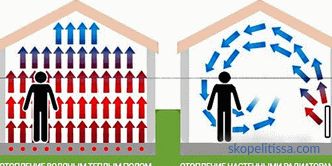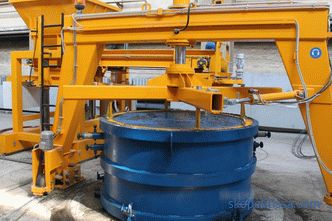An increasing number of homeowners, choosing a finishing coating for interior walls, prefer natural material - wood. This choice is not surprising, because wood combines many useful properties: environmental friendliness, health benefits, beautiful appearance. To these qualities are added excellent operational qualities: low weight, good sound and heat insulation. Lining is the simplest and most affordable wood finishing material, a thin cladding panel with a tongue and groove connection. Painting the wall paneling inside the house is a necessary stage of finishing the dwelling, which makes it possible to give the interior a complete look and solve several additional tasks.
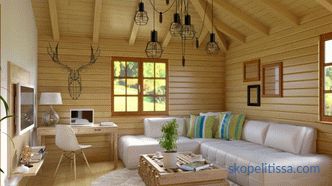
About the need to process the wall panel
Many sincerely believe that wood paneled walls are beautiful in their natural look and do not need additional treatment. Knowledgeable people have several valid objections to this; they indicate the need to protect sheathed walls from the following factors:
-
The action of the ultraviolet . If sunlight regularly hits a wall covered with clapboard, the wood darkens with time, and the walls in the room begin to look different.
-
Color changes . If the house has a poor ventilation system, the air begins to stagnate. Microorganisms develop in places of high humidity and wooden lining may turn blue.
-
Damage to the structure . In a room with excessive moisture in the wood, insect pests start easily, mold sets in; this causes decay and destruction of the finishing layer.
-
Mechanical Damage . A layer of paint will take scratches and bumps and will not spoil the beauty of the walls.
-
From the fire . It is considered reasonable and prudent to protect wooden surfaces from the rapid spread of flame.
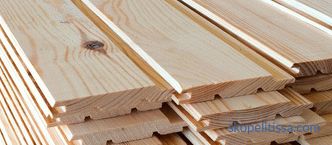
Sometimes the owners think about changing the interior. Lining is easy to upgrade - there are dozens of options for coatings and hundreds of shades that allow you to make familiar rooms unrecognizable.
There is no definite answer to the question of how to paint wood panels inside a country house. The choice is determined by the objectives - whether the owners want only to protect the wooden walls, to refresh the dull surfaces or to change the color drastically. Materials suitable for processing lining, can be divided into two types: protective and decorative.
Protective Compounds
There are many ways to protect a wooden surface from the damaging effects of external factors. Among the means capable of protecting the panel covering are such substances:
-
Flame retardants . This group of compounds is recommended for use in rooms with wooden walls or coatings. Fire retardant impregnation is not able to stop burning, but can significantly delay the spread of fire. This time will be enough to leave the premises and call firefighters, and, perhaps, independently cope with the source of fire.
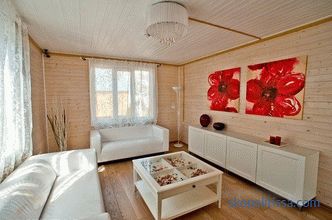
Flame retardants practically do not change the appearance of the wooden surface, and during operation do not emit harmful substances.
-
Antiseptics . Agents with bactericidal properties are used in the fight against biohazard - they are used as a preventive measure, but they are also effective if the infection with a fungus has already begun. The disadvantage of antiseptic treatment is that it must be periodically repeated, as the compositions tend to evaporate. Recently, complex impregnations have appeared that not only cope with mold and wood beetles, but also perform the functions of varnish and stain. Such three-in-one antiseptics create a film on the surface, cost more, but additionally protect the wall panel from moisture and give it a striking look.
-
Stain . A kind of antiseptic impregnation that can penetrate deep into the structure of wooden panels and protect them from unwanted parasite guests. An additional advantage, ensuring the popularity of the stain, is its ability to paint the surface in a deep dark color. A minus means - the panels impregnated with it will seem dull and dirty if not to put a varnish coat from above.
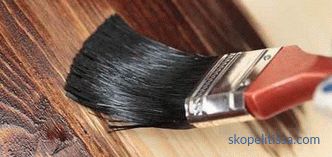
-
Linseed oil . It is used both for the manufacture of quick-drying varnishes and linseed oil, as well as self-impregnation with valuable qualities. Oil is a natural agent that gives the wall paneling water-repellent properties and makes it insensitive to microorganisms.Oil penetrates deep into the material, without creating a film on the surface and allowing wood to breathe. The surface impregnated with linseed oil, more clearly shows the texture and gets a light tint. Impregnation with linseed oil, although relatively inexpensive, will cost more than processing with stain or varnish.
-
Drying . There are natural, synthetic and combined drying oils. Every year they are used less and less - the effect is not the most attractive set of qualities: over time, the surface soaked with linseed oil turns yellow and becomes sticky.
-
Primer . Before using a varnish or paint, a wooden surface is treated with a primer. This base protects the wood from moisture and reduces the consumption of paint and varnish compounds. The decorative layer turns out more equal and attractive by sight.
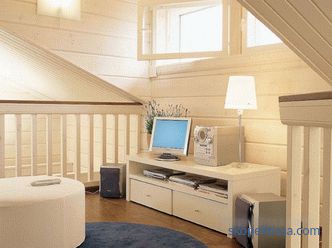
On our website you can find contacts of construction companies that offer the service of finishing and insulation of houses. Directly to communicate with representatives, you can visit the exhibition of houses "Low-rise Country".
-
Bleach . A group of products that allow to get rid of stains of various nature that appear on a wooden surface. Bleach is applied to the problem area, and then washed off with water.
-
Lucky . The lacquer possesses not only protective, but also decorative functions, which is why it is often chosen for processing walls and ceilings from wall paneling. One of the best options for indoor use is acrylic lacquer. Usually it is applied in two layers - the first is transparent, and the second can be tinted. Water-based varnish (aqualak) can create different effects - the walls after its use become glossy, matte or semi-gloss. Aqualak creates a vapor-permeable film on the paneling, often with protection from ultraviolet radiation and microorganisms.
-
Wax . Wax blends are a classic with effective protection. They give wood semi-gloss gloss and serve as a good alternative to varnishes. Manufacturers offer hard wax (they heat it up before working), as well as liquid and water-based (ready to use). The wax composition is difficult to evenly distribute, but the preliminary application of a primer significantly facilitates this process.
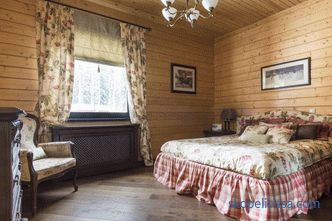
It can be interesting! In the article on the following link, read about painting a concrete fence.
Decorative (covering) products
Decorative means are those that make the color and texture of wood decoration invisible. Sometimes they are used to hide a darkened wooden surface. Decorative options for painting the wall paneling inside the house have a pleasant variety; these include the following varieties of paint and varnish products:
-
Oil paint . An old, proven way to protect and refresh a wall is to coat it with an oil paint that creates a dense, moisture-proof layer. The downside is a long drying paint and its strong smell. Because of this, the work is recommended to perform in the warm season, when the walls dry out and the smell disappears as quickly as possible.
-
Acrylic (acrylic) paint . In many respects, it is a better-quality, easier-to-use material than an oil-based paint. It does not lose color and shine, creates on the surface a waterproof elastic film that does not violate the integrity of the temperature fluctuations. The paint is easy to use - it dries quickly and disappears.
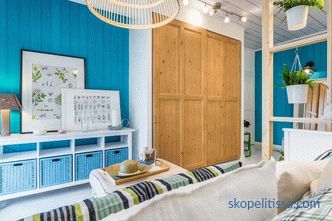
Choosing to paint the wall panel inside the house acrylic paint, it will be correct to use it for the decoration of the walls in the bedroom and the nursery - it is absolutely harmless. The only thing that spoils the impression of acrylic paint is its high price.
-
Acrylic water . An environmentally friendly tool that is gaining in popularity is able to simultaneously decorate and protect walls from clapboard. The tool has a high degree of protection against microorganisms, does not have an unpleasant odor after drying, lays down evenly, without marks and stains when applied. Painting the wall paneling inside the house with an acrylic aqualuck has its own distinct advantage - a wide palette of colors that allows you to create an original interior.
-
Alkyd varnish . This type of paint and varnish products is mainly used in rooms that require regular wet cleaning (kitchen, hall, living room). Color varnish is resistant to abrasion, colorless - also to water. Minus: alkyd varnishes dry for a long time and are expensive.
-
Decorative glaze . Used as an independent decorative composition.May be transparent or colored; in both cases, it favorably emphasizes the texture of the wood panels and protects them from moisture.
About the protection of wood panels in the following video:
-
Opaque enamel . It is advantageous to use it if it is necessary to hide defects on the panel; the layer is dense and solid.
It can be interesting! In the article on the following link read about painting the house inside.
Painting: features and nuances
Having chosen what to paint wooden lining inside the house, they start the process of painting. In order for the result to be of high quality and to please the hosts for many years, the following preparatory work must be done:
-
Stock up on the tool. Paint brushes and a tray, a selected paintwork material, a roller with interchangeable nozzles, a bucket, fine-grained sandpaper and protective gloves will be needed.
-
Clean the surface . The paneling is cleaned from dust, dirt, old coating with a stiff brush or pumice stone, and then treated with sandpaper.
-
Degrease wood . Surface treatment with an alkaline detergent will improve the adhesion (adhesion) of paint to wood.
-
Grind . You can level the surface with pumice, sandpaper or sanding mesh. Pre-defects are filled with putty, the resin is removed with a solvent.
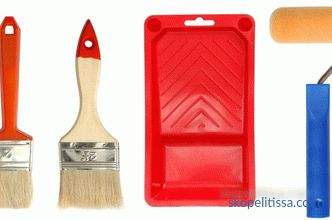
-
Pre to process lining . The primer is applied, after it dries - antiseptic impregnation. The process can be accelerated if you purchase a combination of the combination of both means.
-
Paint the walls . After waiting for the primer to dry and antiseptic, proceed to painting. Paint for lining inside the house is applied in two or three layers. The number of layers depends on the selected material and is indicated in the instructions. It is possible to paint wood panels qualitatively before mounting them on the walls, but this is not always possible (a large awning or canopy is necessary for the procedure).
About painting lining in different colors in the following video:
It might be interesting! In the article on the following link, read about painting a log house.
Useful tips for painting lining
Some subtleties of the workflow will help make painting better. When processing wooden panels take into account such moments:
-
Reduce the cost of painting will help the use of paint and varnish compositions with complex action. Varnish tinted or oil-wax is more expensive, but the effect of its use will be higher.
-
Pre-impregnation of lining should be made from all sides , this will greatly enhance the protective effect.
-
When working with oil paint , its tendency to color change (fading) should be considered. So that over time the change in color does not catch the eye and does not spoil the interior, it’s worth to choose darker, more saturated shades .
-
It is better not to carry out painting on a hot day , since the coating will dry out too quickly and lie unevenly (spots of different saturation may remain).
-
In order for the coating to turn out to be uniform in color , the mixture needs to be mixed periodically during operation.
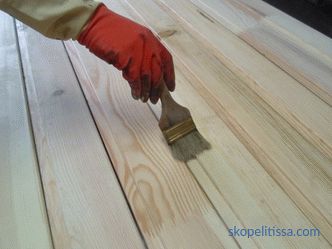
-
To the color of the walls was uniform , you can add color finishes (paint) to the primer.
-
When choosing a painting composition , take into account the total costs : not only its cost, but also the recommended number of layers, as well as paint consumption per 1 m².
Choosing a color for painting lining
The cladding-lined walls are the background for creating the interior of a country house, so choosing the right shade is no less important than choosing the optimal paintwork. So that the choice of color for wood panels does not violate the harmony of the design, follow the following rules:
-
For walls, choose a shade that differs by no more than a few colors from the ceiling color and floor. Contrast transitions harm the overall style (only if the interior is not designed in any of the avant-garde styles).
-
White is a classic way to expand the space and make it lighter. It adds elegance to the interior, blends well with other shades and hides surface defects well.
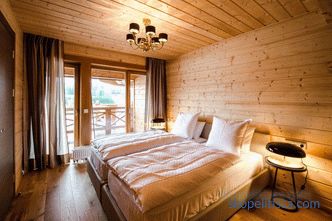
-
In the design living room and kitchen on walls lined with clapboard, best of all look like light and warm colors : cream, peach, brown.
-
The interior of the nursery allows the use of bright colors (for which, high-quality and safe acrylic paints are ideal). In the bedroom the walls, lined with wooden panels, try to varnish natural shades or calm colors - purple, beige, honey. For the decoration of the walls of the cabinet a gray-blue or brown-green gamma is suitable.
It can be interesting! In the article on the following link read about painting a wooden house.
Conclusion
Wall lined with clapboard is an effective and practical way of interior design of a country house. For the coating to turn out to be long-term, careful preliminary preparation of the wood panels is necessary. Qualitatively processed and painted lining will emphasize the interior design and save you from too frequent repairs.
Rate this article, we tried for you
